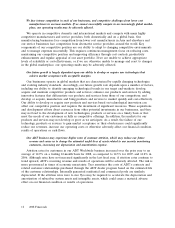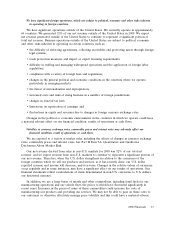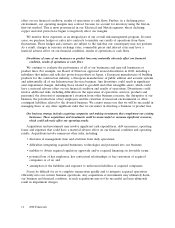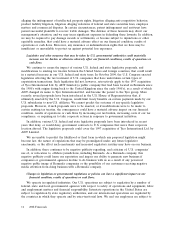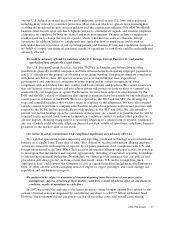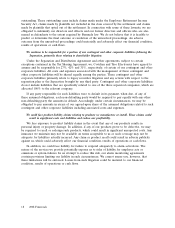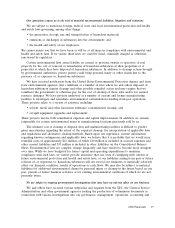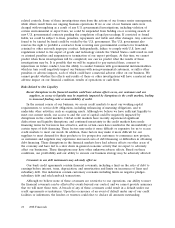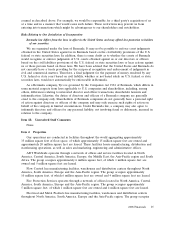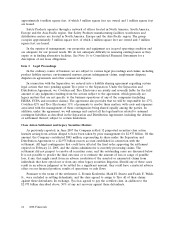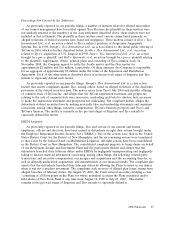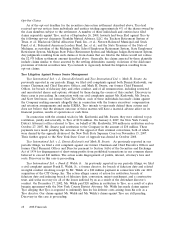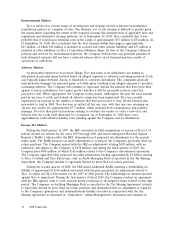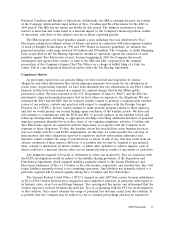ADT 2008 Annual Report Download - page 125
Download and view the complete annual report
Please find page 125 of the 2008 ADT annual report below. You can navigate through the pages in the report by either clicking on the pages listed below, or by using the keyword search tool below to find specific information within the annual report.tax amounts in the Consolidated Balance Sheet. During fiscal 2008, the Company completed the first
phase of a remediation plan to address these control deficiencies which included performing account
reconciliations on income tax accounts globally. As of September 26, 2008, we have determined,
however, that the material weakness continues to exist and requires further remediation in the form of
process improvements and subsequent assessment.
A material weakness in our internal control over financial reporting could adversely impact our
ability to provide timely and accurate financial information. While considerable actions have been taken
to improve our internal controls in response to the material weakness described above, additional work
continues. If we are unsuccessful in implementing or following our remediation plan, we may not be
able to timely or accurately report our financial condition, results of operations or cash flows or
maintain effective disclosure controls and procedures. If we are unable to report financial information
timely and accurately or to maintain effective disclosure controls and procedures, we could be subject
to, among other things, regulatory or enforcement actions by the SEC and the New York Stock
Exchange, including a delisting from the New York Stock Exchange, securities litigation, debt rating
agency downgrades or rating withdrawals, any one of which could adversely affect the valuation of our
common stock and could adversely affect our business prospects.
Examinations and audits by tax authorities, including the Internal Revenue Service, could result in
additional tax payments for prior periods.
The Company and its subsidiaries’ income tax returns periodically are examined by various tax
authorities. In connection with these examinations, tax authorities, including the IRS, have raised issues
and proposed tax adjustments. We are reviewing and contesting certain of the proposed tax
adjustments. Amounts related to these tax adjustments and other tax contingencies and related interest
that management has assessed under FIN No. 48 have been recorded through the income tax provision,
equity or goodwill, as appropriate. The calculation of our tax liabilities involves dealing with
uncertainties in the application of complex tax regulations in a multitude of jurisdictions across our
global operations. We recognize potential liabilities and record tax liabilities for anticipated tax audit
issues in the United States and other tax jurisdictions based on our estimate of whether, and the extent
to which, additional income taxes will be due. These tax liabilities are reflected net of related tax loss
carryforwards. We adjust these liabilities in light of changing facts and circumstances.
In 2004, in connection with the IRS audit of the 1997 through 2000 years, the Company submitted
to the IRS proposed adjustments to certain prior period U.S. federal income tax returns resulting in a
reduction in the taxable income previously filed. During 2006, the IRS accepted substantially all of the
proposed adjustments, and the Company developed proposed amendments to U.S. federal income tax
returns for additional periods through 2002. On the basis of previously accepted amendments, the
Company has determined that these adjustments will more-likely-than-not be accepted and, accordingly,
has recorded such adjustments in the Consolidated Financial Statements. Such adjustments did not
have a material impact on the Company’s financial condition, results of operations or cash flows.
Additionally, during 2008 the Company completed proposed amendments to its U.S. federal
income tax returns for periods subsequent to 2002, which primarily reflect the roll forward through
2006 of the amendments for the periods 1997 to 2002. Such adjustments did not have a material impact
on the Company’s financial condition, results of operations or cash flows. While the final adjustments
cannot be determined until the income tax return amendment process and the IRS review is completed,
the Company believes that any resulting adjustments will not have a material impact on its financial
condition, results of operations or cash flows.
22 2008 Financials


